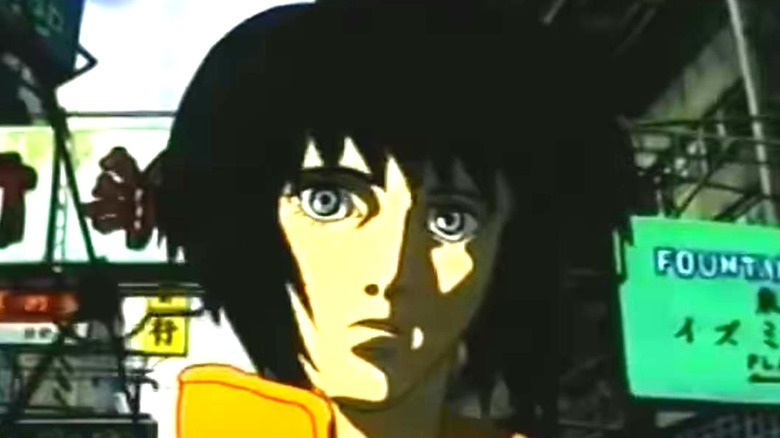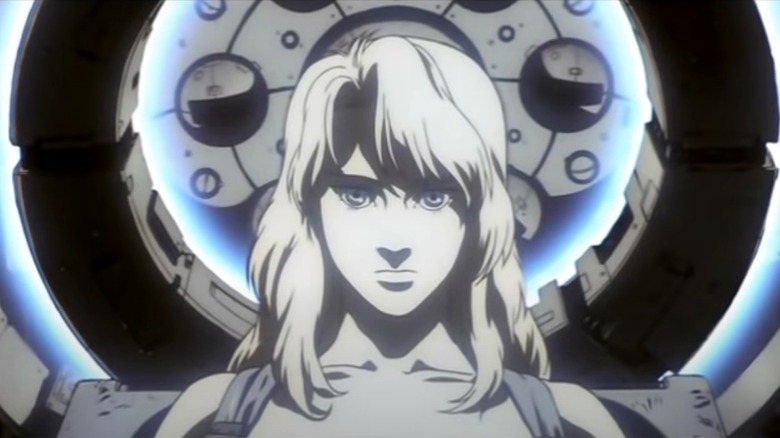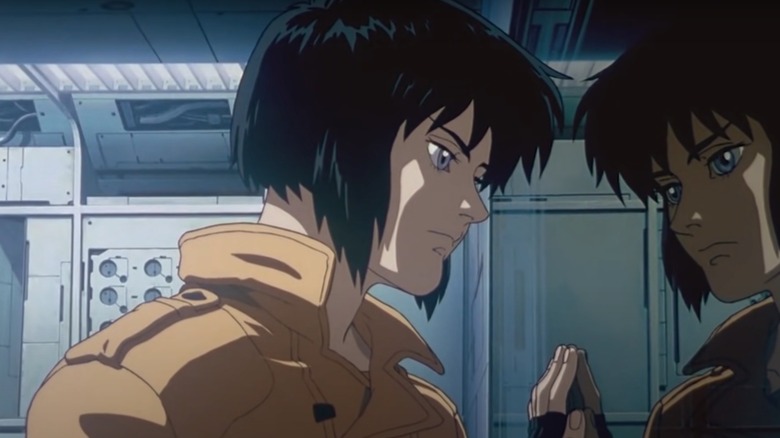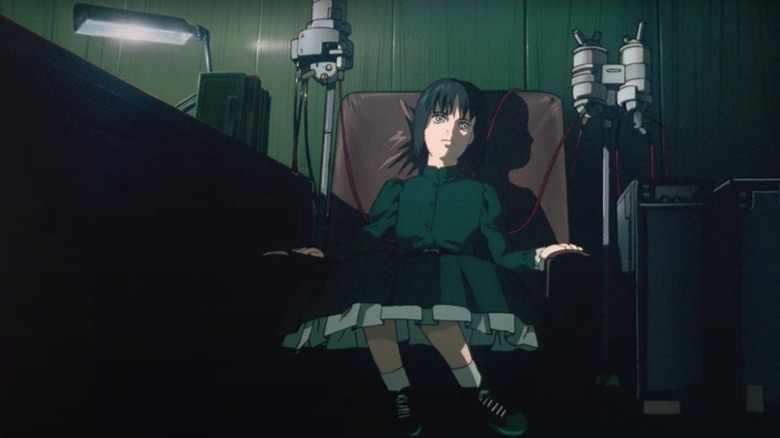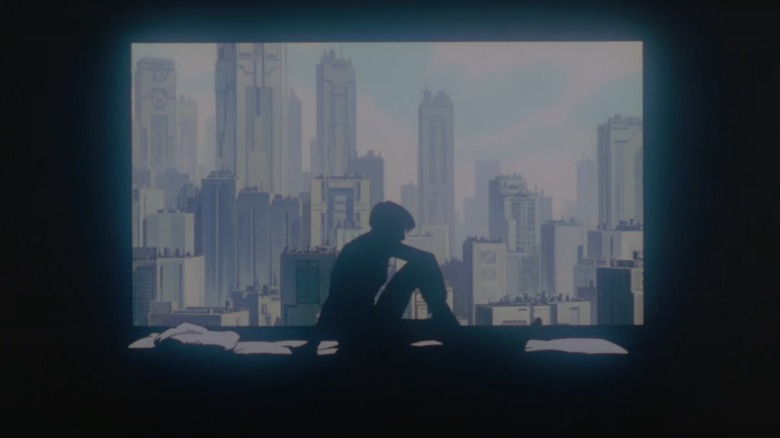The Ending Of Ghost In The Shell Explained
Nothing says iconic '90s anime quite like 1995's "Ghost in the Shell." It's one of the best anime movies of all time and a quintessential part of the cyberpunk genre that has had a far-reaching influence past just animation.
In an adaptation of the original manga, "Ghost in the Shell" imagines a future in which humans are enhancing their bodies with technology, but can be hacked and manipulated with altered memories. Among them is Major Motoko Kusanagi (Atsuko Tanaka), a cyborg working for a black ops government organization called Section 9 that's intent on taking down the mysterious master hacker known as the Puppet Master (Iemasa Kayumi).
The action is spectacular and inventive, but the movie is more known for its deep dive into complex philosophies of what it means to be human. The characters talk about their "ghost" like it's their soul or consciousness, while the titular "shell" is their body, which can be modified or completely artificial. In the end, Kusanagi's questioning of herself leads her to take a different approach while confronting the Puppet Master ...
The Puppet Master is an AI made by the government
In "Ghost in the Shell," we first hear of the Puppet Master as having hacked into an interpreter, potentially to use her to assassinate people meeting with the Foreign Minister. He's been meddling in various foreign affairs, utilizing his unparalleled hacking abilities to manipulate people, often by altering their memories. At first, the team at Section 9 assumes the Puppet Master is a human, but in actuality, the Puppet Master originated as a program created by Section 6 under the name Project 2501.
Section 6 created it to interfere with foreign affairs, but he developed his own consciousness and rebelled. They then trap him in a cyborg body, but he escapes and makes a spectacle of himself in order to get closer to Section 9 and, more specifically, Major Motoko Kusanagi. However, Section 6 wants to cover their tracks and keep people from learning about Project 2501, so they send helicopters to shoot and destroy him. Unfortunately for them, they are just a little too late.
Kusanagi finds herself and merges with the Puppet Master
While the Puppet Master and Section 6 are the primary antagonists of "Ghost in the Shell," much of the film is about Major Motoko Kusanagi reckoning with her own humanity and individuality (or lack thereof). Many people in this future world have had technological alterations done to their body, but Kusanagi has a fully artificial cyborg body — save for a few human brain cells tucked somewhere in her robot brain.
She's wracked with uncertainty over who she is, and whether or not she counts as a person, often thinking about being someone else. Her colleagues all want to capture or kill the Puppet Master, but she wants to learn about herself from him. They finally meet in an abandoned natural history museum, where Kusanagi rips herself apart in an attempt at disabling the tank protecting him. It's an intense moment that shows she still has her limits, despite her cyborg body, but also hints that she's come to value her ghost more than her shell.
When Kusanagi "dives" into the Puppet Master, he proposes that the two of them merge into one being. Curiously, Kusanagi says she wants a guarantee she will still be herself, suggesting she's found some meaning in who she is. However, the Puppet Master argues that all things change and trying to stay the same limits her. He feels incomplete because he can't reproduce, but he and Kusanagi merging is akin to them reproducing because it results in a new being.
Section 6 breaks the party up, guns ablazing, but Kusanagi makes her choice before it's too late. Batou puts her ghost in a new shell when he attaches her head to a new cyborg body. When she speaks to him, she reveals that she did merge with the Puppet Master and is now neither Kusanagi nor Project 2501, but something new.
The merge is evolution past humanity
"Ghost in the Shell" is packed to the gills with complex themes and philosophies, from humanity's relationship with technology to the question of "what is life, anyway?" to the necessity of change for growth. Kusanagi's merge with the Puppet Master is akin to evolution, emphasized by the imagery of the Tree of Life on the museum's wall being destroyed by bullets.
In an interview with The AV Club, Director Mamoru Oshii said, "[B]efore, people tended to think that ideology or religion were the things that actually changed people, but it's been proven that that's not the case. I think nowadays, technology has been proven to be the thing that's actually changing people." Oshii certainly was all in on the philosophy, as he added, "The producers often say, "Instead of using all these philosophical phrases, why don't you change this into an action scene?" But I don't do that."
Kusanagi's words to Batou in the final scene emphasize this theme of progress. Her journey through the movie is full of imagery of reflections, as she contemplates her own identity and thinks about being someone else. She dives into the ocean for a little hope, and her dive into the Puppet Master is for a similar reason. In the last scene, we view Kusanagi's reflection in a mirror through her own eyes, before she references the words she thought on the boat and completes the saying: It's a Bible verse about being limited in understanding and seeing only a reflection of the truth, but having the knowledge that a day will come when that understanding is expanded. Kusanagi, who felt so confined before as someone who's not quite human and not quite computer, finds freedom in her new form. Now, she can traverse the sea of information.
Ghost in the Shell inspired Hollywood
Despite a lackluster box office record, "Ghost in the Shell" has been hugely influential on Hollywood. Most obviously, the Wachowskis were inspired by it when making "The Matrix" — the iconic green digital rain comes from the "Ghost in the Shell" opening credits, and the plug at the back of the neck calls back to Kusanagi's similar attachment. Beyond them, filmmakers James Cameron and Steven Spielberg are known to be fans, according to The Guardian.
When talking about "The Matrix" and "Ghost in the Shell" with IGN, director Mamoru Oshii said, "I don't really think it's about who stole what from whom, but there was a time when Japanese animation borrowed a lot from American filmmaking, so it's a mutual relationship ... There was a time in Japan when every anime movie borrowed from '2001: A Space Odyssey' or 'Blade Runner' or 'The Terminator.'"
Since 1995's "Ghost in the Shell," the franchise has expanded to include a sequel and several series in the same setting, though with a new continuity. It even got its own live-action remake in 2017, with Scarlett Johansson as Major Kusanagi (aka Mira Killian), which featured callbacks to the original with its many Easter eggs. Despite its stunning visuals, critics and fans believe the 2017 movie doesn't capture the esoteric, yet enrapturing soul of the original.
Ultimately, "Ghost in the Shell" leaves a lot up for interpretation, so do with it what you will.
